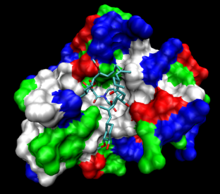FKBP
| FKBP-type peptidyl-prolyl cis-trans isomerase | |||||||||
|---|---|---|---|---|---|---|---|---|---|

The human protein FKBP12 bound to FK506 (tacrolimus). The protein surface is colored by hydrophobicity; the deep cleft in which the ligand is bound is hydrophobic.
|
|||||||||
| Identifiers | |||||||||
| Symbol | FKBP_C | ||||||||
| Pfam | PF00254 | ||||||||
| InterPro | IPR001179 | ||||||||
| PROSITE | PDOC00426 | ||||||||
| SCOP | 1fkb | ||||||||
| SUPERFAMILY | 1fkb | ||||||||
|
|||||||||
| Available protein structures: | |
|---|---|
| Pfam | structures |
| PDB | RCSB PDB; PDBe; PDBj |
| PDBsum | structure summary |
FKBP, or FK506 binding protein, is a family of proteins that have prolyl isomerase activity and are related to the cyclophilins in function, though not in amino acid sequence. FKBPs have been identified in many eukaryotes from yeast to humans and function as protein folding chaperones for proteins containing proline residues. Along with cyclophilin, FKBPs belong to the immunophilin family.
FKBP12 is notable in humans for binding the immunosuppressant molecule tacrolimus (originally designated FK506), which is used in treating patients after organ transplant and patients suffering from autoimmune disorders. Tacrolimus has been found to reduce episodes of organ rejection over a related treatment, the drug ciclosporin, which binds cyclophilin. Both the FKBP-tacrolimus complex and the ciclosporin-cyclophilin complex inhibit a phosphatase called calcineurin, thus blocking signal transduction in the T-lymphocyte transduction pathway. This therapeutic role is not related to prolyl isomerase activity.
FKBP (FKBP1A) does not normally form a dimer but will dimerize in the presence of FK1012, a derivative of the drug tacrolimus (FK506). This has made it a useful tool for chemically induced dimerization applications where it can be used to manipulate protein localization, signalling pathways and protein activation.
...
Wikipedia
